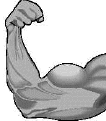BACKGROUND:
The internal body structure is very difficult for children
to imagine. We do not have corpses available for students this young
to learn about internal anatomy. People are left with their outside
body to help decipher what their inside body looks like. In this
activity, the students are looking for external clues as to how their insides
are working. External names are head, abdomen, legs, arms, torso,
and fingers. But under each of these external parts are the organs that
make our body work as a fine-tuned machine.
PROCEDURE:
- If you have a skeletal model, ask students
if the outside of our body reflects the inside. Students should understand
that our entire form is because of the structure of our skeleton.
The outside can help us understand the inside.
- There are 10 tasks that the students observe which are
listed under "body parts." The students will then describe what they
see and then try to interpret what systems the various parts belong to.
Each of the parts of the body is explained below. You should leave
adequate time to go over each of the parts so the students understand what
they actually observed.
- MOVEMENT OF CHEST (up and down) - RESPIRATORY
When air enters the lungs, they "blow up" like a balloon.
The expanded lungs push on the rib cage and make the entire chest move
up and down. Students should use a stethoscope to listen to their lungs.
They can put the stethoscope on their back to listen. It is much
better to put the stethoscope on skin. So if they have a partner
they might want to listen to the lungs through their back. But if
the student is doing it their body, they can listen from their front.
- NAILS (tips of fingers and toes) - SENSORY
The nails are modified outer skin cells. New nail cells
take place as the nail moves forward and grows in length. The crescent
or moon at the base of the nail is called the lunula which is the living
nail. Use the magnifying lense to look at this are closely.
- PULSE (beating) - CIRCULATORY
A pulse is caused when blood goes through the arteries of the
heart. The heart is a strong muscle that "squirts" blood through
the arteries as the blood leaves the heart. The blood will return
through the veins, but this action does not produce a pulse. Use
the stethoscope to listen to their blood move, they can either listen to
their own heart or they can listen on their wrist or neck.
- FOLD UNDER EYES - CIRCULATORY
Students should move the skin under the eye down, to see the
pink capillaries. If they do not have a partner, they will require a mirror.
You can see very small blood vessels.
- UNDERSIDE OF TONGUE - CIRCULATORY
Blood vessels are difficult to observe. Have students look
at either their underside of their tongue using a  mirror or their partner's
tongue. They will see thick blue lines (veins), thick pink lines
(arteries) and tiny hair-thin lines which are capillaries. Arteries
take the blood away from the heart, the blood is rich in oxygen and is
red. Veins take blood that has lost its oxygen toward the heart and
the blood looks blue. Capillaries are a system of blood vessels that
join the veins and arteries. When students look at the fold under
their eye (pull slowly down to expose a small area), they will see capillaries. mirror or their partner's
tongue. They will see thick blue lines (veins), thick pink lines
(arteries) and tiny hair-thin lines which are capillaries. Arteries
take the blood away from the heart, the blood is rich in oxygen and is
red. Veins take blood that has lost its oxygen toward the heart and
the blood looks blue. Capillaries are a system of blood vessels that
join the veins and arteries. When students look at the fold under
their eye (pull slowly down to expose a small area), they will see capillaries.
- MID BACK - SKELETAL
To observe their vertebrae have students touch their back or
partner's back midway. Have them press slightly so they can feel
the segmented vertebrae. The students can feel the bone better if the other
student hunches over. Students can also feel their own vertebrae
that run along the middle of their back. Have students use the bag
of bones to observe where the vertebrate is located.
- SKIN - SENSORY
The skin and eyes are part of several systems, but they have
to do with the senses. Note that we are using the sensory system
which is not a real system. Most elementary text books use
sensory as a system and this is probably easier for children to understand.
Students may ask you abou t goose pimples which are an involuntary muscle
reaction which causes the hair to "stand on end." t goose pimples which are an involuntary muscle
reaction which causes the hair to "stand on end."
- ARM, FLEX - MUSCULAR
The biceps get large as you flex your muscle. Muscle cells
contract and become larger. Students should make a muscle slowly.
The partner should feel the muscles and how they contract as the muscles
is being made.
- ARM, BEND - MUSCULAR
In this activity
have the students just bend their arm with no force. If you add no
force nothing will happen.  Muscles can only contract. Muscles can only contract.
- HAIR - SENSORY
Hair is a modified form of skin cells. Hair cells are
produced at the embedded
tip of the hair follicle in the skin. Students should use a magnifying lens to look at the hair follicles.
- In the conclusion, we ask the students to determine which
system does the human body most reflect. The skeletal system basically
controls the overall shape of the human body.
|